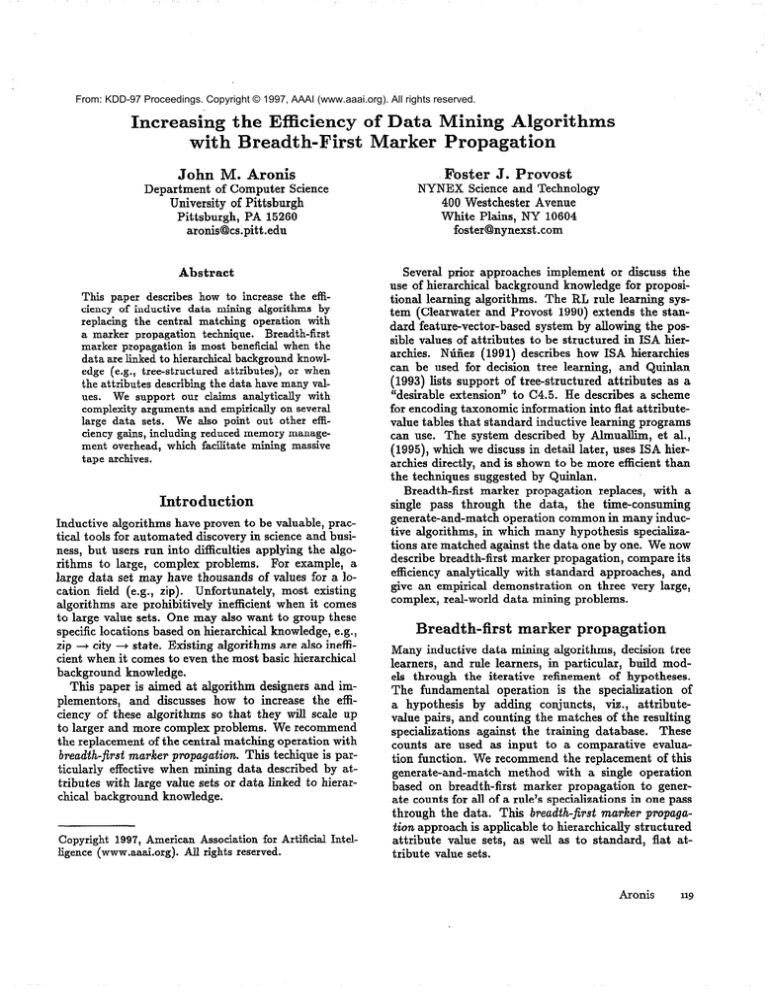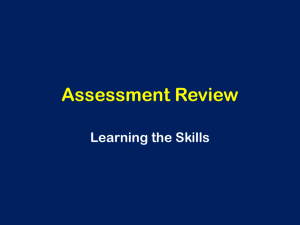
From: KDD-97 Proceedings. Copyright © 1997, AAAI (www.aaai.org). All rights reserved.
Increasing
the Efficiency
with Breadth-First
Mining Algorithms
Propagation
Foster J. Provost
John M. Aronis
NYNEX Science and Technology
400 Westchester Avenue
White Plains, NY 10604
fosterQnynexst.com
Department of Computer Science
University of Pittsburgh
Pittsburgh, PA 15260
aronisQcs.pitt.edu
Abstract
This paper describes how to increase the efficiency of inductive data mining algorithms by
replacing the central matching operation with
a marker propagation technique.
Breadth-first
marker propagation is most beneficial when the
data are linked to hierarchical background knowledge (e.g., tree-structured
attributes),
or when
the attributes describing the data have many values. We support our claims analytically
with
complexity arguments and empirically on several
large data sets. We also point out other efficiency gains, including reduced memory management overhead, which facilitate mining massive
tape archives.
Introduction
Inductive algorithms have proven to be valuable, practical tools for automated discovery in science and business, but users run into difficulties applying the algorithms to large, complex problems. For example, a
large data set may have thousands of values for a location field (e.g., zip). Unfortunately, most existing
algorithms are prohibitively inefficient when it comes
to large value sets. One may also want to group these
specific locations based on hierarchical knowledge, e.g.,
zip -+ city + state. Existing algorithms are also inefficient when it comes to even the most basic hierarchical
background knowledge.
This paper is aimed at algorithm designers and implementors, and discusses how to increase the efficiency of these algorithms so that they will scale up
to larger and more complex problems. We recommend
the replacement of the central matching operation with
breadth-first
marker propagation. This techique is par&-.nla.rly
effective when -‘
mining
by at-------o data
-~~~- described
--~ ~~~
tributes with large value sets or data linked to hierarchical background knowledge.
Copyright 199’7, American Association for Artificial
ligence (www.aaai.org).
All rights reserved.
of Data
Marker
Intel-
Several prior approaches implement or discuss the
use of hierarchical background knowledge for propositional learning algorithms. The RL rule learning system (Clearwater and Provost 1990) extends the standard feature-vector-based system by allowing the possible values of attributes to be structured in ISA hierarchies. NGiiez (1991) d escribes how ISA hierarchies
can be used for decision tree learning, and Quinlan
(1993) lists support of tree-structured attributes as a
“desirable extension” to C4.5. He describes a scheme
for encoding taxonomic information into flat attributevalue tables that standard inductive learning programs
can use. The system described by Almuallim, et al.,
(1995), which we discuss in detail later, uses ISA hierarchies directly, and is shown to be more efficient than
the techniques suggested by Quinlan.
Breadth-first marker propagation replaces, with a
single pass through the data, the time-consuming
generate-and-match operation common in many inductive algorithms, in which many hypothesis specializations are matched against the data one by one. We now
describe breadth-first marker propagation, compare its
efficiency analytically with standard approaches, and
give an empirical demonstration on three very large,
complex, real-world data mining problems.
Breadth-first
marker
propagation
Many inductive data mining algorithms, decision tree
learners, and rule learners, in particular, build models through the iterative refinement of hypotheses.
The fundamental operation is the specialization of
a hypothesis by adding conjuncts, viz., attributevalue pairs, and counting the matches of the resulting
specializations against the training database. These
counts are used as input to a comparative evaluation function. We recommend the replacement of this
-^-^-+A ..--1
-..L,l.
g~ll~lQI1c;-QIIIIl-~~~~~~~
‘-a.L,..l
UIF;sJAL”U
. . ..+L
WIUI
.
a
,:,.-A...
JLnpT
A_.... ..+:A..
vpzsarrvu
based on breadth-first
marker propagation to generate counts for all of a rule’s specializations in one pass
through the data. This breadth-first
marker propagation approach is applicable to hierarchically structured
attribute value sets, as well as to standard, flat attribute value sets.
Aronis
119
Training examples are typically viewed as vectors of
attribute-value pairs to be matched against. Instead,
consider them to be vectors of bidirectional pointers
into the value space. Given that you want to specialize
a k-conjunct hypothesis R (e.g., a rule or a decisiontree branch), breadth-first marker propagation generates counts of matches for all possible specializations
as follows. The data structure VALUESET contains the
set of values with non-zero counts, which will be used
as indices to retrieve the counts.
1. For each conjunct of R, mark the corresponding
value with a conjunct mark: (which we will denote
&>*
2. Following pointers, propagate these marks to the
training instances, tallying how many marks accumulate on each instance.
3. For those instances with L conjunct marks, i.e., those
that satisfy all Ic conjuncts of R, mark the instance
with its class (e.g., + or -).
4. Now, for each instance, and for each attribute,
propagate the instance’s class mark to the attribute value
present in the instance. At each attribute value, keep
a running tally of the number of marks of each type.
Add to VALUESET a pointer to each value marked.
5. For hierarchies of values, propagate tallies
of marks
in a breadth-first fashion from the leaves of the hierarchy to the root. Parent tallies are the sums of
the corresponding child tallies. Add to VALUESET a
pointer to each value visited.
Figure 1: A Simple Data Mining Problem.
Square
Item-l
Polygon
cl ++
Item-2
z
Item-3
Shape
,
.>
COkN
>
Item-4
ISA
Figure 2: Network Representation of Simple Problem.
120
KDD-97
We will illustrate the algorithm on a simple problem. Consider the database given in Figure 1, corresponding to the network of pointers shown in Figure 2.
Suppose the learner wants to specialize the hypothesis
color=blue
+ +. We first mark blue with &, then move
that marker down links onto items 2, 3, and 4. Since
each of these items now has one & marker, corresponding to the single conjunct of the current hypothessis,
we mark each item with its class (+ or -). Then, these
markers are moved forward across links and tallied on
:a
:ll..r+r.a+ar
\
z..B,h
\rl‘ru
IY +h.,
“&IV o+.a+n
U”cbYI, 4ha
“llcs a:.x~r~m
urcb~jrarrr
uuU”La.“~Y.,
~culrllnode. Pm&
Notice that the node Polygon accumulates two + markers and no - markers, indicating a perfect match of the
positive examples.
Complexity
Analysis
We first consider the complexity of hypothesis specialization in the case without ISA hierarchies. Assuming
that there are e examples, a attributes, and (on average) w values for each attribute, even very efficient
inductive algorithms based on matching require O(e)
matches for each of O(aw) potential specializations of
each hypothesis for a time complexity of O(eaw), as
described recently by Domingos (Domingos 1996).
Now consider a learner that uses breadth-first
roar&
propaoa.tinn
“0”“----
to replace
~Fatcj&g.
-A-&r
ws&-
ing through the examples once, each of the possible
specializations will have class counts tallying all the
examples that match it. The counts can be retrieved
by walking through VALUESET, which (with no value
hierarchies) can have no more than ae elements. The
overall time complexity, O(ae), is independent of the
number of values. Thus, marker propagation should
scale better for problems with large sets of values.
Now consider the case where attributes can have hierarchical, tree-structured values. The state of the art
in efficient learning with value hierarchies is described
by Almuallim, et al. (1995). They show their method,
which we will call the AAK-direct
approach, to be more
efficient than other methods. It differs from our marker
propagation technique in that it walks each attribute
---I--- __Tr.7A ul-2
vaue
up At__
me TL,
IJXI LZ-----Lnierarcny :-~:--!~--llmuiviuua~y. TXT2l.L
vvlbn 13x
erarchies of depth d, computing counts for e examples
and a attributes takes time O(ead).
Because breadth-first marker propagation combines
counts at each level and propagates tallies of markers up ISA hierarchies, the process takes O(ea + s)
time, where s is the total number of values visited. It
is clear that the set of values visited by breadth-first
marker propagation is the same as the set values visited by the AAK-direct approach. Rowever, breadthfirst marker propagation visits each value only once.
Thus, in the worst case, where no two examples share
a value, and no two values share intermediate tree
nodes as ancestors, marker propagation is equivalent
to the AAK-direct approach. In any non-degenerate
case, where there exists at least one place in the visited ISA hierarchy where its branching factor is greater
than one, marker propagation will be more efficient
than the AAK-direct approach.
Moreover, for very large datasets, breadth-first
marker propagation introduces efficiency benefits that
are not apparent from the complexity analysis alone.
Consider, again, the hypothesis specialization step.
lT-nor Q atiributes an& w values, mi-ttch’iiiig metho&
typically make au passes through the set of e data
items. Even more savvy programs, e.g., C4.5 (Quinlan 1993), make a passes through the set of e examples. Breadth-first marker propagation performs only
one pass through the data, performing a operations on
each item. This introduces a huge savings in disk accesses if the data set does not fit in main memory. For
example, an n-level decision tree can be built with only
n passes through the exampie set.
Empirical
Demonstrations
To demonstrate the analytical results, we replaced
matching with breadth-first marker propagation in the
RL (Clearwater and Provost 1990) rule-learning algo,:+l..,
DT\
lib.,
+hnls
&..A:,,
1.r.3 ..I_
LL”ILUI famrn
\PCI”u--ILU,.
X”I
IrlLcx3~
JYUUrciy
WG UJG a beam
search and a depth limit to restrict the search space of
rules, use the rule certainty factor defined by Quinlan
(1993) to evaluate potential rules, and accept rules if
their evaluation is above a user-defined threshold.
To test our first analytical result that, even without hierarchical background knowledge, breadth-first
marker propagation is more efficient than conventional
matching as the number of attribute values grows, we
- ---L--!---l a sequence
~~~
,I--- consisring
--..-!-II-.- 01
-r,,-,
nnn
symneslzea
01r--proolems
IU,UUU
training examples with 10 attributes and an increasing number of values randomly assigned to these attributes. These tests were performed on a DECstation
5000 with 64Mbytes of memory.
Figure 3 compares BFMP-RL’s run time with that
of RL using generate-and-test matching (MATCHINGRL). Note that for these and the following experiments, the different systems performed identical
searches and produced identical rnie sets. As predicated analytically, the run time with breadth-first
marker propagation remains nearly constant as the
number of values increases, while the run time with
matching increases linearly.
Our second analytical result predicts that breadthfirst marker propagation will be more efficient than
prior approaches when dealing with deep ISA hierarchies. Figure 4 shows the effect of increasing the depth
of ISA hierarchies on breadth-first marker propagation
compared with a version of RL using the AAK-direct
approach. Again, the empirical results support the
analytical results: breadth-first marker propagation is
strikingly more efficient for deep ISA hierarchies.
To provide further support to our claim that
breadth-first marker propagation is an efficient mechanism for learning with large data sets connected to
background knowledge, we ran BFMP-RL on three realworld data sets with one million examples each, linked
Figure 3: BFMP-RL vs. MATCHING-RL with Increasing Number of Values.
to large ISA hierarchies of background knowledge.
BFMP-RL’s first learning task is to discover potential indicators of fraudulent cellular telephone calling
behavior (Fawcett and Provost 1996). The training
data comprise one million examples of cellular telephone calls. The data are linked to a hierarchy of
domain knowledge about 1400 geographic locations of
particular telephone numbers arranged in an ISA hierarch-y of rL?nt,ll
--I.- --- three6 For these euperi:mentc we 1used
23 attributes with 18,000 total values.
We also analyzed a data set comprising U.S. Department of Health birth records linked with records
of infant deaths. BFMP-RL was used to learn rules to
predict infant mortality and survival. The database
contains one million records with about twenty fields
each, including demographic factors, birthweight, etc.
The goal of the learning is to identify subgroups of the
r.nn.,l~t;nn
w;th
h;rrh
lnrl ~,m,~c,.sllv
low., Lu:ny”&.Pl.uuu~“IL
..&“II ,,n,,c.,,~ll.r
u.“UYYuyJ
I”pL
UILU
UlruuuuvJ
A”.”
fant mortality rates, in order to direct further research.
The long-term goal of such work is to formulate policies that will reduce the nation’s infant mortality rate
(Provost and Aronis 1996).
Finally, we analyzed data describing incidents of potentially toxic exposures to plants. The database contains about one million records including symptoms,
recommended actions, actual actions, outcome, as well
as demographic and symptom information about the
victims and information about the plant substances.
We used 20 of these fields. These data were linked
to background knowledge hierarchies describing geographic regions (1014 distinct areas), climate types (55
types), and botanical classifications (2400 individual
species, genera, and families) (Krenzelok, Jacobsen,
and Aronis 19953.
Figure 5 shows the effect on BFMP-RL of increasing
the number of data items for these three real-world
Aronis
121
when learning problems contain hierarchically structured values, and that even without such structures
the technique is an efficient replacement for matching. Furthermore, minimizing the number of passes
through the example set avoids memory-management
thrashing, and provides a method to mine archived
datasets. Finally, breadth-first marker propagation
links data mining to basic ideas from knowledge representation. In order to focus on efficiency gains, we have
limited the discussion in this paper to ISA-hierarchical
background knowledge. However the use of marker
propagation provides a means to learn with more complex networks of background knowledge and multitable
databases (Aronis, Provost, and Buchanan 1996).
Acknowledgements
Figure 4: BPMP-RL versus AAK-direct
ISA Depth.
Figure 5: BFMP-RL
with Increasing
References
with 10,000 to l,OOO,OOOItems.
data sets up to l,OOO,OOOitems. BFMP-RL searched
for rules of up to 5 conjuncts, using a beam width
of 50. We note that, with these settings, MATCHINGRL took nearly two hours to learn with 100,000 examples and no ISA hierarchy. Furthermore, it is practically impossible to run MATCHING-RL on this workstation with many more than 100,000 items due to
memory-management thrashing. On 100,000 cellular
fraud examples BFMP-RL performed a relatively thornnrrh
.zac)”
cpnrrh
““.“A”&.
nf
--
the
~IJ]C
C~RCC?
defined
“~-“”
- -_-----
hv
-J
21
-L
features
-.-_-_2-
with 18,000 total values in an ISA hierarchy of depth 3
in under 5 minutes minutes on a desktop workstation.
Conclusions
We have shown that breadth-first marker propagation is an efficient alternative to existing approaches
122
KDD-97
This research was supported by National Science Foundation grant IRI-9412549.
Almuallim, H.; Akiba, Y.; and Kaneda, S. 1995. On
handling tree-structured
attributes in decision tree
learning. In Proceedings of the Twelfth International
t--..C.F,,..,,,
,...
‘I”~a.LIIIIIC
M,,L:..,
Tucxarrrrrr~,
,..,..:,.-.
19 -cm
ns--,
““ILI~:ICIIL-z
“II
.&I-*“.
LVLVS@mr
Kaufmann.
Aronis, J.; Provost, F.; and Buchanan, B. 1996. Exploiting background knowledge in automated discovery. In Proceedings of the Second International Conference on Knowledge Discovery and Data Mining, 335358. AAAI Press.
Clearwater, S.; and Provost, F. 1990. RL4: A tool
for knowledge-based induction. In Proceedings of the
Second International IEEE Conference on Tools for Artificial Intelligence, 24-30. IEEE C.S. Press.
Domingos, P. 1996. Linear-Time Rule Induction. In
Proceedings of the Second International Conference on
Knowledge Discovery and Data Mining, 96-101. AAAI
Press.
Fawcett, T.; and Provost, F. 1996. Combining data
mining and machine learning for effective user profiling. In Proceedings of the Second International Conference on Knowledge Discovery and Data Mining, 813. AAAI Press.
Krenzelok, E.; Jacobsen, T.; and Aronis, J. 1995.
Jimsonweed (datura stramonium) poisoning and abuse
. . . an analysis of 1,458 cases. Presented at 1995 North
American Congress of Clinical Toxicology, abstract in
Clinical Toxicology, 33(5).
Ntiiiez, M. 1991. The use of background knowledge in
decision tree induction, &-a&&e Learning 6:23i-250.
Provost, F.; and Aronis, J. 1996. Scaling up inductive
learning with massive parallelism. Machine Learning,
23~33-46.
Quinlan, J. 1993. C4.5: Programs for Machine Learning. Morgan Kaufmann.



